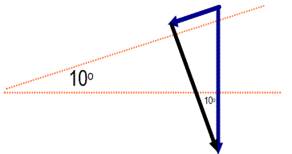
To find: the magnitude force required to push an object along the ramp that is inclined at certain angle with the horizontal.
Answer to Problem 16E
17.36 pounds
Explanation of Solution
Given information:
Weight of an object = 100 pounds
Angle of inclination =
Calculation:
The force must be at least greater as the component of the weight of the object in the direction of the ramp. The sketch for the given situation is as follows:

The magnitude of the force can be evaluated as shown below.
Thus the magnitude of required force is 17.36 pounds.
Chapter 8 Solutions
Advanced Mathematical Concepts: Precalculus with Applications, Student Edition
Additional Math Textbook Solutions
University Calculus: Early Transcendentals (4th Edition)
Thinking Mathematically (6th Edition)
Introductory Statistics
Pre-Algebra Student Edition
Algebra and Trigonometry (6th Edition)
Elementary Statistics: Picturing the World (7th Edition)
- The answer is B, Could you please show the steps to obtain the answerarrow_forward2. Suppose that U(x, y, z) = x² + y²+ z² represents the temperature of a 3-dimensional solid object at any point (x, y, z). Then F(x, y, z) = -KVU (x, y, z) represents the heat flow at (x, y, z) where K > 0 is called the conductivity constant and the negative sign indicates that the heat moves from higher temperature region into lower temperature region. Answer the following questions. (A) [90%] Compute the inward heat flux (i.e., the inward flux of F) across the surface z = 1 - x² - y². (B) [10%] Use the differential operator(s) to determine if the heat flow is rotational or irrotational.arrow_forwardCould you show why the answer is B Using polar coordinates and the area formulaarrow_forward
- 1. The parametric equations x = u, y = u cos v, z = usin v, with Ou≤ 2, 0 ≤ v ≤ 2π represent the cone that is obtained by revolving (about x-axis) the line y = x (for 0 ≤ x ≤2) in the xy-plane. Answer the following questions. (A) [50%] Sketch the cone and compute its surface area, which is given by dS = [ | Ər Or ди მა × du dv with S being the cone surface and D being the projection of S on the uv-plane. (B) [50%] Suppose that the density of the thin cone is σ(x, y, z) = 0.25x gr/cm². Compute the total mass of the cone.arrow_forwardThe value of sin (2V · F) at x = 3, y = 3, z = −4, where F -0.592 -0.724 0.661 -0.113 -0.822 -0.313 0.171 0.427 = (-2x² + -4,2yz − x − 3, −5xz - 2yz), isarrow_forwardThe correct answer is C Could you show me whyarrow_forward
 Calculus: Early TranscendentalsCalculusISBN:9781285741550Author:James StewartPublisher:Cengage Learning
Calculus: Early TranscendentalsCalculusISBN:9781285741550Author:James StewartPublisher:Cengage Learning Thomas' Calculus (14th Edition)CalculusISBN:9780134438986Author:Joel R. Hass, Christopher E. Heil, Maurice D. WeirPublisher:PEARSON
Thomas' Calculus (14th Edition)CalculusISBN:9780134438986Author:Joel R. Hass, Christopher E. Heil, Maurice D. WeirPublisher:PEARSON Calculus: Early Transcendentals (3rd Edition)CalculusISBN:9780134763644Author:William L. Briggs, Lyle Cochran, Bernard Gillett, Eric SchulzPublisher:PEARSON
Calculus: Early Transcendentals (3rd Edition)CalculusISBN:9780134763644Author:William L. Briggs, Lyle Cochran, Bernard Gillett, Eric SchulzPublisher:PEARSON Calculus: Early TranscendentalsCalculusISBN:9781319050740Author:Jon Rogawski, Colin Adams, Robert FranzosaPublisher:W. H. Freeman
Calculus: Early TranscendentalsCalculusISBN:9781319050740Author:Jon Rogawski, Colin Adams, Robert FranzosaPublisher:W. H. Freeman
 Calculus: Early Transcendental FunctionsCalculusISBN:9781337552516Author:Ron Larson, Bruce H. EdwardsPublisher:Cengage Learning
Calculus: Early Transcendental FunctionsCalculusISBN:9781337552516Author:Ron Larson, Bruce H. EdwardsPublisher:Cengage Learning





